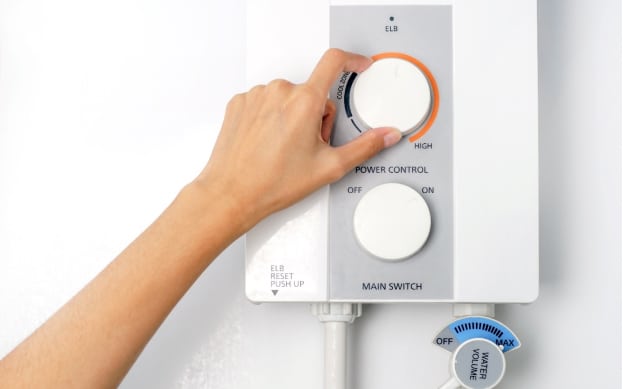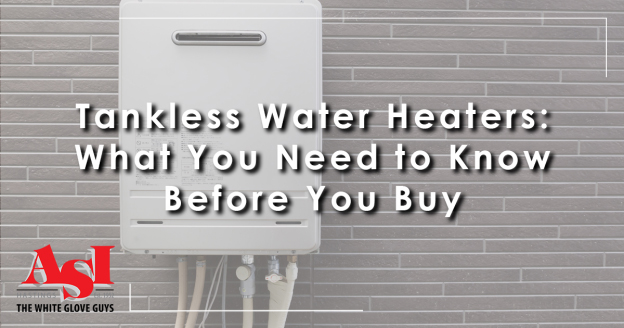Your water heater plays a crucial role in your home’s comfort and function, providing hot water for cooking, cleaning, and bathing. However, if you have several people taking showers or baths at the same time, run a dishwasher, or use high-capacity washing machines, the hot water may run out quickly.
Tankless water heaters, or on-demand water heaters, can be a solution in homes that use a lot of hot water. Unlike conventional water heaters that store large quantities of water and take up space, tankless water heaters create hot water as needed.
If you’re considering a tankless water heater, it’s important to understand the types of on-demand water heaters, their pros and cons, and how to determine if they’re the right choice for your home. Here’s everything you need to know.
What Is a Tankless Water Heater?
Tankless water heaters heat water on demand without the need for a storage tank. They’re also called on-demand, demand-type, or instantaneous water heaters. Storage water heaters have 50-gallon tanks that heat water on standby so it’s ready for use, but tankless water heaters only heat the water when it’s necessary.
When a hot water faucet is turned on, cold water flows through the heat exchanger in the unit using an electric element or natural gas burner to generate hot water instantly. As a result, tankless water heaters are more energy efficient than storage water heaters because there’s no standby heat loss.
Types of Tankless Water Heaters
There are different types of water heaters with different features and functionality.
Point-of-Use Tankless Water Heaters
Point-of-use tankless water heaters are small and may be stored in a cabinet or closet. They are typically designated for individual units, such as one shower, sink, or faucet. Point-of-use tankless water heaters are less expensive than a unit designed for the whole house, but you will need multiple to serve extra fixtures.
Whole-House Tankless Water Heaters
Whole-house tankless water heaters are more expensive than point-of-use units. They have a higher GPM flow rate capacity and can manage multiple fixtures in your home, such as a dishwasher and several showers, running at the same time. The size and number of whole-house tankless water heaters are determined by the flow rate and how many fixtures you want to run at the same time. In large homes, you may want more than one tankless water heater to accommodate your needs.

Electric Tankless Water Heaters
Electric tankless water heaters use an electric-resistance heating coil, which is a metal heating element that heats up when electricity passes through it to transfer heat to the water and heat it. These can be more expensive to run than gas.
Gas Tankless Water Heaters
Gas tankless water heaters use natural gas or propane with a gas-fired burner. They have a flow sensor that initiates combustion. The gas valve opens and gas enters the chamber ignited by a spark to produce a flame, which heats an exchanger and the water. Because of national gas regulations, these systems require vending.
There are condensing and non-condensing gas models. The former maximizes energy use with a dual heat exchanger, while the latter has only one heat exchanger. Condensing gas models are more energy efficient and lose less heat than non-condensing models.
Solar Tankless Water Heaters
Though less common than electric or gas models, solar tankless water heaters work with home’s that have a solar energy system. These systems work with clean energy, but they can be expensive to purchase and install.
Pros and Cons of a Tankless Water Heater

Tankless water heaters can be the ideal solution for many homes, but there are some compromises you have to make. Here are the pros and cons of tankless water heaters.
Pros
- Energy savings: Based on data from the U.S. Department of Energy, if your home uses 41 gallons or less of hot water daily, demand water heaters can be24% to 34% more energy efficient than a conventional tank water heater. However, if you use more water each day, you won’t experience such dramatic savings.
- Storage savings: Tankless water heaters are always smaller than storage water heaters. They are ideal for small spaces, including closets, pantries, or storage areas. That said, you do need to know what size tankless system is appropriate for your home, which requires calculations for the required temperature and the flow rates for your fixtures.
- Longevity: Tankless water heaters have a lifespan of about 20 years. Conventional water heaters only last about 10 or 15 years.
- Enhanced safety: Tankless water heaters are safer than conventional water heaters because they don’t store gallons of water. There’s no risk of spilling gallons if they leak or harboring bacteria in stored water. And because the air supply and exhaust vents are sealed, carbon monoxide can’t leak into your home.
- Easy winterization: If you need to winterize your home for the season, draining a conventional water heater tank is tedious and time consuming. Tankless water heaters are easy to drain in a few seconds. Then, all you have to do is unplug them.
- Extra features: Tankless water heaters come in electric and natural gas or propane models. Some tankless models can only heat smaller amounts of water, but others can support multiple people showering or multiple hot-water appliances running at the same time.
Cons
- Higher upfront price: Tankless water heaters are more expensive to purchase and install than conventional water heaters. However, the trade off is that they last longer and have lower energy costs over their lifespan, so they’re more cost effective.
- Fixture flow rate: Water is heated more effectively when the water flows through the unit more slowly. You have to have fixtures that have a flow rate of no more than 2.2 GPM at 60 PSI. TheFederal Energy Policy Act of 1992 requires this upgrade, but homes with older fixtures may not meet it.
- Climate matters: Tankless water heaters work with the natural groundwater temperature, so they may not be effective in extremely cold climates. The colder the groundwater gets, the less hot water the unit can produce. They also need to work harder to warm cold water in cold areas, which can increase your energy use.
Conventional Storage Water Heater vs. Tankless Water Heater
Still not sure which is right for you? Let’s compare conventional storage water heaters and tankless water heaters.

Conventional water heaters have tanks that can store 30 to 60 gallons, though the average is about 50 gallons. They need ample storage space that’s at least six feet by two feet. They are less expensive than their tankless counterpart in size and capacity, because most homes have conventional water heaters installed already and they only need to be replaced. The installation costs are typically lower.
Typically, tankless water heaters are installed when there’s a new construction home or major renovation. Otherwise, homeowners often just replace their aging storage water heater with a new model.
Here’s a side-by-side comparison:
| Conventional Storage Water Heater | Tankless Water Heater |
| Less expensive to purchase
Simple installation Uses a lot of energy to heat the standby tank Requires ample storage space Less environmentally friendly Average 10- to 15-year lifespan |
More expensive to purchase
More expensive to install Cost-effective in energy expenditure and savings Requires less storage space Environmentally friendly Average 20-year lifespan |
How to Choose the Right Tankless Water Heater
If you’ve decided a tankless water heater is the right choice for you, it’s crucial to ensure that you’re getting the model that will best suit your needs. it takes some research and comparison. Here are some tips:
Speak to a professional HVAC technician about your requirements for hot water use, budget, space, and installation. You should also discuss different features and warranty options to determine what may benefit you.
Compare different models that have the capacity and features you want. Make sure to evaluate features and options, including average energy usage and warranties.
Read reviews on models you’re considering. Find out what users liked and didn’t like about each model and look for trends, such as features that were especially helpful or problems that multiple people experienced.
What Size Tankless Water Heater Do I Need?
It’s best to consult a professional and experienced HVAC technician to determine what tankless water heater you need, but here are some basic

Tankless water heaters need a big burst of BTUs to turn cold water into hot water in a matter of seconds. If the heater’s BTU output can’t keep up with your demand, it will reduce the water flow or deliver lukewarm water.
To ensure your tankless water heater is up to the task, an HVAC pro will consider:
- The temperature of the water coming into the heater
- The peak demand for hot water in gallons per minute (GPM)
- The heaters efficiency based on the Uniform Energy Factor
They calculate how many BTUs per gallon a heater needs to increase the incoming water to 120 degrees and the sum of the flow rates for every appliance and fixture (peak demand). The total is reduced by 20%, since most people aren’t using 120-degree water for bathing.
The total BTU output is calculated with this formula:
BTUs per gallon X peak hot water demand (x 0.8) X 60 minutes ÷ Uniform Energy Factor = Total BTU output
If the output falls between two models, the one with the higher BTU rating is preferred. If the output is higher than 198,000 BTUs, which is the maximum for residential heaters, you’ll need multiple smaller units.
Upgrade to a Tankless Water Heater
If a tankless water heater seems like the right choice for you, talk to a pro to determine the right size and model for your home. Contact us at ASI Heating & Air to schedule your consultation!









